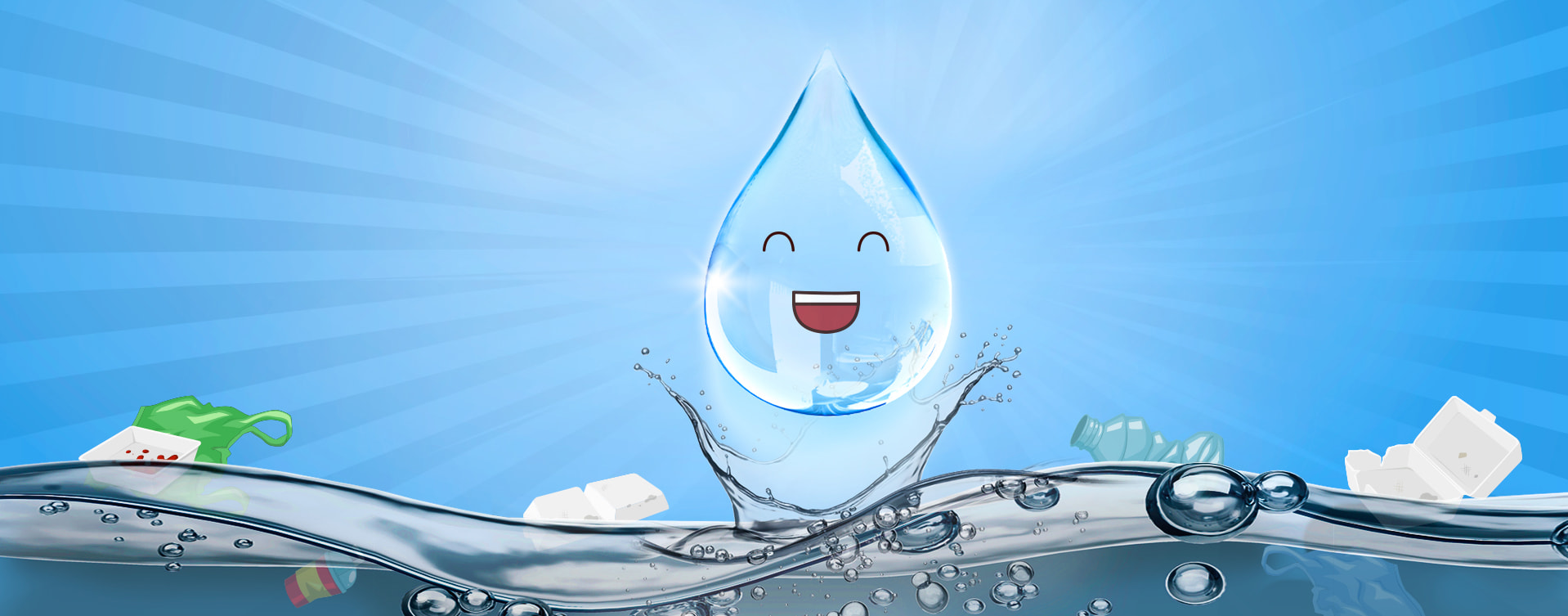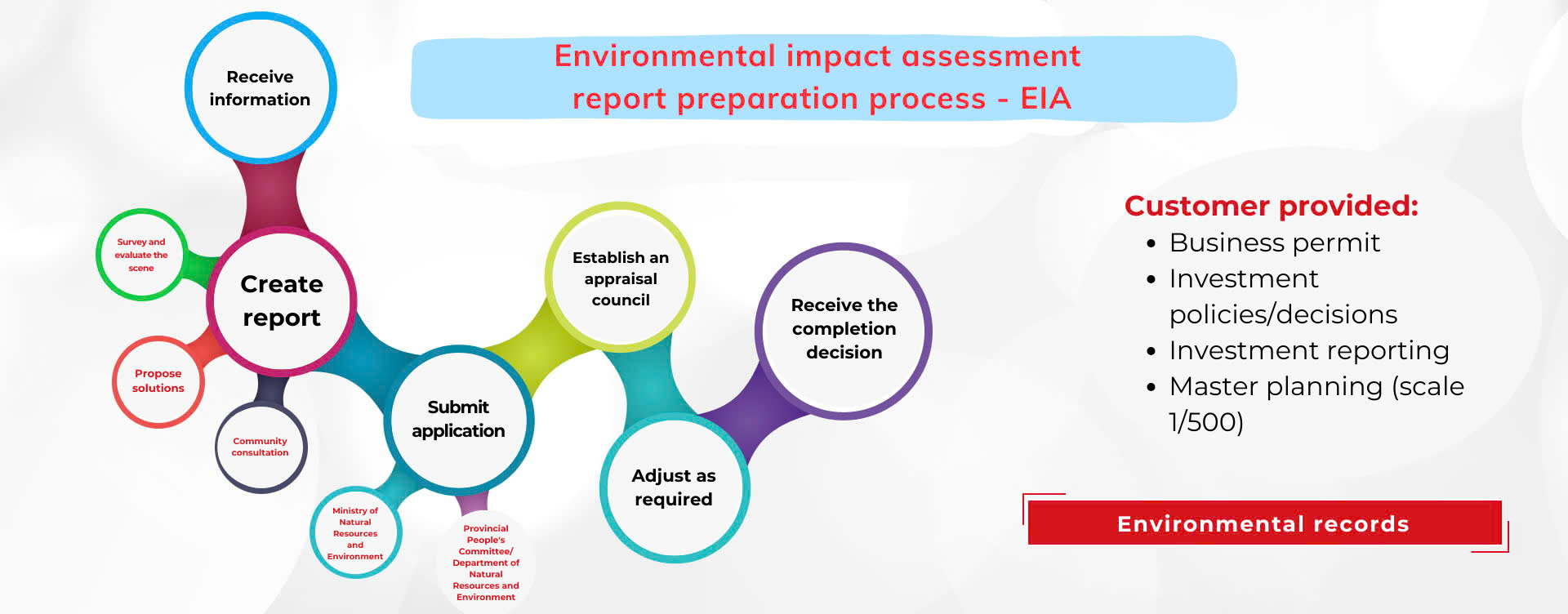Wastewater treatment module
Wastewater treatment module
- WeMe – Specializing in Construction and Installation of Wastewater Treatment Modules
- Advantages of Installing the Wastewater Treatment Module
- Notable WeMe Wastewater Treatment Projects
- Operation Mechanism of Wastewater Treatment Module Using MBR Technology from WeMe
- WeMe Wastewater Treatment Module
- Classification and Characteristics of Different Types of Wastewater
- Overview of Treatment Technologies for Various Types of Wastewater
Wastewater Treatment Module by WeMe Uses Modern Technology, Compact Design, and Can Be Applied to Various Types of Wastewater. Its Effectiveness Surpasses Traditional Wastewater Treatment Systems. Additionally, It Helps Save Investment Costs, Maintenance Costs, and Design Space.
WeMe – Specializing in Construction and Installation of Wastewater Treatment Modules
WeMe Energy Joint Stock Company confidently ensures to provide wastewater treatment modules with flexible capacities, tailored to customers’ needs. WeMe guarantees:
- Quality of treated wastewater meets regulatory standards;
- System warranty period is 12 months;
- Initial operational training for the investor by WeMe’s engineers;
- Full package services for transportation, construction, and installation;
- 24/7 free support and consultation on related issues or legal documents.
Customers interested in installing a wastewater treatment machine using MBR membrane filtration technology, please contact WeMe specialists immediately to receive consultation, support, and more detailed information. It is an honor for WeMe to accompany you.
Advantages of Installing the Wastewater Treatment Module
WeMe’s wastewater treatment module uses aerobic biological technology combined with MBR microfiltration membranes, making it offer certain advantages when installed in a wastewater treatment system. Installing the module helps simplify construction works, save space, and reduce initial investment costs while still ensuring that the treated wastewater meets the QCVN standards.
- Compact module, space-saving, easy to transport and install.
- No need for settling, filtering, or disinfection tanks once installed.
- MBR membrane made of highly durable and elastic C-PVC material can be periodically cleaned and reused without needing replacement.
- Easily upgradeable up to 20% capacity without increasing tank volume.
- Fully automated operation with almost no chemicals used in the treatment process.
- The module applies the most advanced MBR membrane filtration technology today, ensuring the treated wastewater meets QCVN standards.
- The module is made of thick SS400 steel, coated with Epoxy paint to minimize wear and rusting.
Notable WeMe Wastewater Treatment Projects
WeMe takes pride in being trusted by many domestic businesses to provide solutions to wastewater issues. Below is information about some notable wastewater treatment projects implemented by WeMe:
Project: Dong Phuong Plastic Joint Stock Company
- Wastewater Type: Domestic wastewater.
- System Capacity: 5 m³/day-night.
- Project Location: 2B Luong Van Can, Ward 15, District 8, Ho Chi Minh City.
- Treated Water Quality Requirement: QCVN 14:2008/BTNMT Column A.
Project: Thanh Khe District Health Center
- Wastewater Type: Domestic and medical wastewater.
- System Capacity: 5 m³/day-night.
- Project Location: K62/32 Ha Van Tap, Thanh Khe District, Da Nang City.
- Treated Water Quality Requirement: QCVN 14:2008/BTNMT Column B.
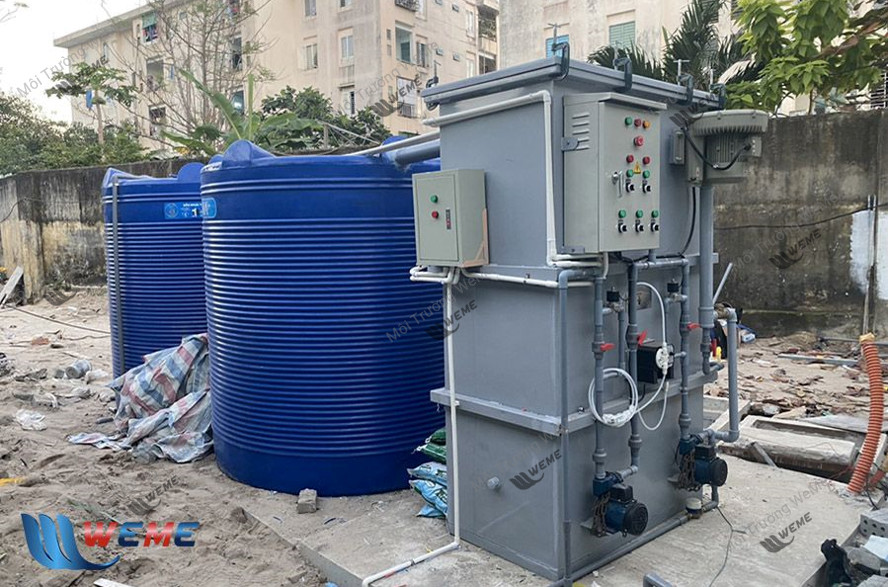
Project: Acteam International Company
- Wastewater Type: Domestic wastewater.
- System Capacity: 15 m³/day-night.
- Project Location: Da Ron Commune, Don Duong District, Lam Dong Province.
- Treated Water Quality Requirement: QCVN 14:2008/BTNMT Column A.
Project: Rice Noodle Production Facility by Mr. Dao Duy Phuong
- Wastewater Type: Domestic wastewater and wastewater from rice noodle production.
- System Capacity: 5 m³/day-night.
- Project Location: Group 4, Lien Thanh Hamlet, Vinh Phuong Commune, Nha Trang City.
- Treated Water Quality Requirement: QCVN 14:2008/BTNMT Column B.
Project: Tam Phuc General Hospital
- Wastewater Type: Domestic and medical wastewater from the hospital.
- System Capacity: 75 m³/day-night.
- Project Location: 82A Ngo Si Lien, Duc Thang Ward, Phan Thiet City, Binh Thuan Province.
- Treated Water Quality Requirement: QCVN 28:2010/BTNMT Column B.
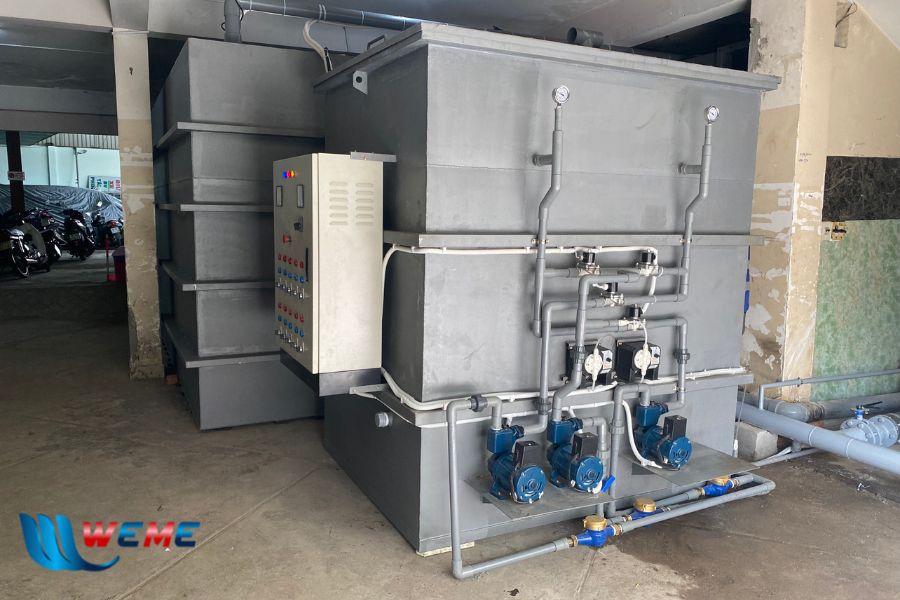
Project: Lap Phuc Co., Ltd
- Wastewater Type: Domestic wastewater.
- System Capacity: 40 m³/day-night.
- Project Location: 193 Go O Moi, Quarter 2, Phu Thuan Ward, District 7, Ho Chi Minh City.
- Treated Water Quality Requirement: QCVN 14:2008/BTNMT Column A.
Operation Mechanism of Wastewater Treatment Module Using MBR Technology from WeMe
Technology Diagram Explanation
Collection Pit:
Wastewater, after being separated from trash, grease, and oil, is collected in the pit before being sent to the treatment system. This separation helps to remove large debris like plastic bags, paper, leaves, glass shards, and gravel to avoid clogging pipes and pumps during operation and protect mechanical equipment from wear and tear.
Equalization Tank:
Air is supplied to stir the wastewater, preventing sedimentation and anaerobic decomposition, which can cause odors. The tank stabilizes the concentration and flow rate of the wastewater. The wastewater is then pumped into the anoxic tank.
Anoxic Tank:
Phosphorus is converted and NO3- is reduced to N2 gas, which escapes into the atmosphere. The concentration of P and N in the wastewater is reduced to allowable levels. The wastewater then flows into the aeration tank.
Aeration Tank:
Organic matter is removed through the activity of aerobic microorganisms, which use organic compounds in the wastewater as a food source to grow and multiply. These compounds are broken down into simpler substances. Air is continuously supplied through blowers and diffusers installed at the bottom of the tank.
MBR Module:
This consists of flat, parallel filter membranes submerged in the aeration tank. Aerobic treatment continues here. The MBR membrane, with microfiltration size, retains sludge, microorganisms, and suspended solids, allowing only clean water to pass through.
The treated water meets the required standards by the Ministry of Natural Resources and Environment for discharge into receiving sources after passing through WeMe’s MBR wastewater treatment technology.
Special Features of WeMe’s Wastewater Treatment Module
While MBR technology offers high treatment efficiency, membrane clogging can occur, reducing treatment performance due to dirt accumulation on the membrane surface. Understanding this, WeMe has integrated an automatic membrane cleaning mechanism into the module.
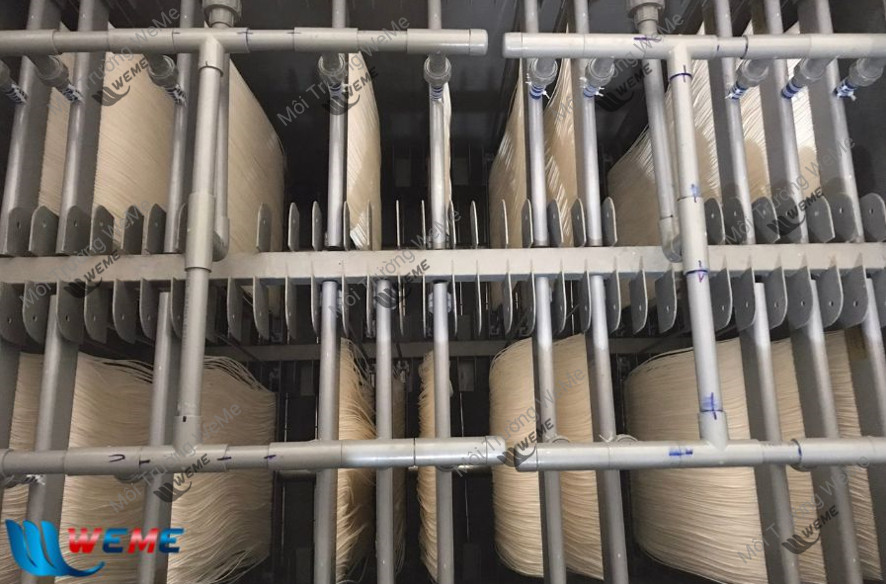
Specifically, after a period of operation (usually several hours), the system will stop to backwash the MBR membrane for about 5 minutes. During this time, water, along with chlorine bleach, is introduced into the module for cleaning through dosing pumps and a cleaning pump mounted on the module. Additionally, during operation, air blowers provide airflow to dislodge accumulated dirt on the membrane, ensuring smooth operation and maximum treatment efficiency.
WeMe Wastewater Treatment Module
Specifications
- Product Name: Wastewater Treatment Module
- Capacity: 5m³/day-night – 30m³/day-night
- Power Supply: 3-phase – 380V
- MBR Tank Dimensions: 1,200 x 650 x 2,050 mm (length x width x height)
- Technology: Aerobic biological treatment combined with MBR membrane filtration
- Structure: Integrated, solid unit
- Design and Installation Unit: WeMe Energy Joint Stock Company
Equipment List
| No. | Equipment Name | Brand | Unit | Quantity |
|---|---|---|---|---|
| 1 | MBR Membrane | Mitsubishi | Sheet | 2 – 12 |
| 2 | Air Blower | Taiwan | Unit | 1 – 2 |
| 3 | Submersible Pump | Taiwan | Unit | 2 |
| 4 | Horizontal Pump | Panasonic | Unit | 2 |
| 5 | Dosing Pump | Hanna | Unit | 1 |
| 6 | Float Switch | Taiwan | Unit | 1 |
| 7 | Control Cabinet & Wiring | LS Components | System | 1 |
| 8 | Pipe System & Accessories | Vietnam | System | 1 |
| 9 | MBR Tank & Frame | WeMe | System | 1 |
High Applicability of Wastewater Treatment Modules
Choosing the right wastewater treatment technology and system is a complex issue that investors always strive to solve in the best way possible. So how is the high applicability of the wastewater treatment module demonstrated?
The wastewater treatment module can be applied and effectively treat most types of wastewater such as domestic wastewater, medical wastewater, industrial wastewater, etc.
The treatment capacity is flexible, ranging from 5 – 40 m³/day:
- Capacity 5 m³/day
- Capacity 15 m³/day
- Capacity 30 m³/day
Optimizes installation costs and space for investors.
Classification and Characteristics of Different Types of Wastewater
Classification of Wastewater
Based on the source of origin, wastewater is divided into the following main types:
- Domestic wastewater: Wastewater from the daily activities of households and service business establishments (restaurants, hotels, tourist areas, etc.).
- Industrial wastewater: Wastewater generated from the operations and production processes of factories and enterprises in the industrial sector.
- Agricultural wastewater: Wastewater generated from activities such as farming, cultivation, and livestock.
- Medical wastewater: Wastewater from medical establishments such as hospitals, clinics, and pharmaceutical manufacturing facilities.
Analysis of the Characteristics of Each Type of Wastewater
| No. | Type of Wastewater | Characteristics | Discharge Standard |
|---|---|---|---|
| 1 | Domestic wastewater | Organic matter (BOD, COD), nutrients (N, P,..), pathogenic microorganisms | QCVN 14:2008/BTNMT |
| 2 | Industrial wastewater | Depends on the production type: organic pollution, oil, grease, heavy metals,… | QCVN 40:2011/BTNMT |
| 3 | Agricultural wastewater | Contains residues of pesticides, fertilizers, organic matter, pathogenic microorganisms,… | QCVN 62-MT:2016/BTNMT |
| 4 | Medical wastewater | Suspended solids, organic matter, pathogenic microorganisms, pharmaceutical residues,… | QCVN 28:2010/BTNMT |
| 5 | Food wastewater | Organic and inorganic substances, microorganisms: viruses, bacteria (some of which are non-harmful), BOD, COD, N, P | QCVN 40:2011/BTNMT |
It can be seen that each type of wastewater has different pollution loads and discharge flows. They also have their own discharge standards, requiring facilities to treat them before discharging into the environment. Understanding the characteristics of each type of wastewater helps apply the wastewater treatment module effectively to achieve higher treatment efficiency.
Overview of Treatment Technologies for Various Types of Wastewater
In general, for each type of wastewater, pollution indicators such as organic and inorganic pollution, suspended solids, heavy metals, and pathogenic microorganisms vary. However, wastewater treatment systems generally follow similar processes, including:
- Mechanical Treatment: Removes coarse debris, insoluble substances, and large sediments (e.g., screening, oil skimming, sand settling tanks).
- Physicochemical Treatment: Removes small suspended particles that are difficult to settle from the water (e.g., coagulation-flocculation tanks).
- Biological Treatment: Uses the activity of microorganisms to treat organic pollution and nutrients (e.g., UASB tanks, anoxic tanks, aerotanks).
- Wastewater Disinfection: Removes pathogenic microorganisms (e.g., disinfection tanks).
Depending on the type of production, pollution load, and discharge flow, investors can choose the appropriate treatment technology, build the system, or install wastewater treatment modules for the best efficiency.

